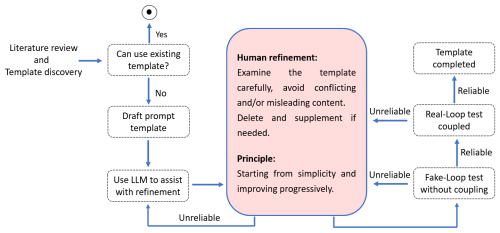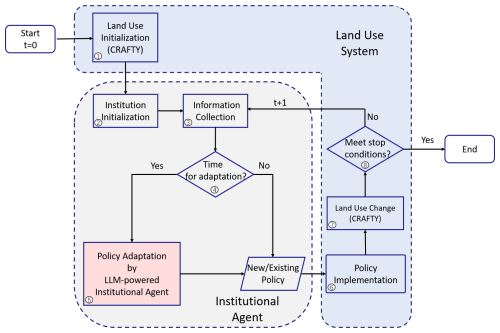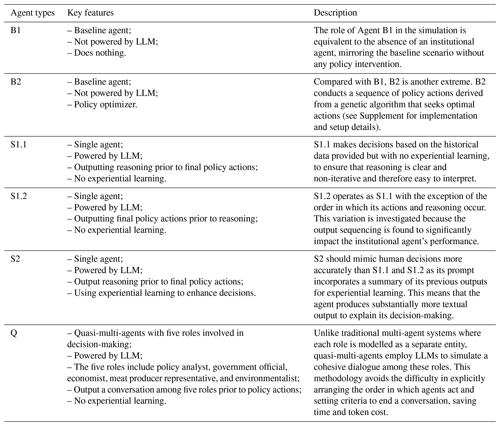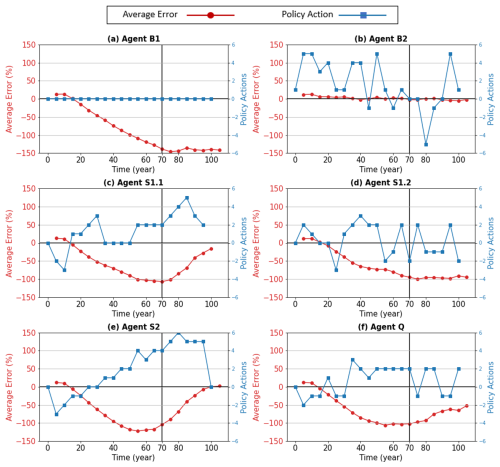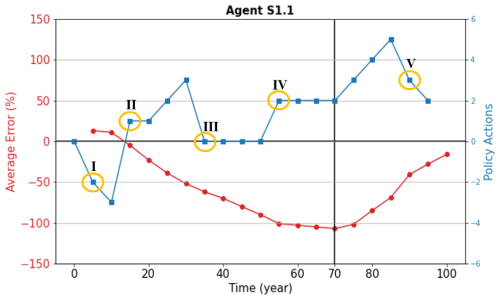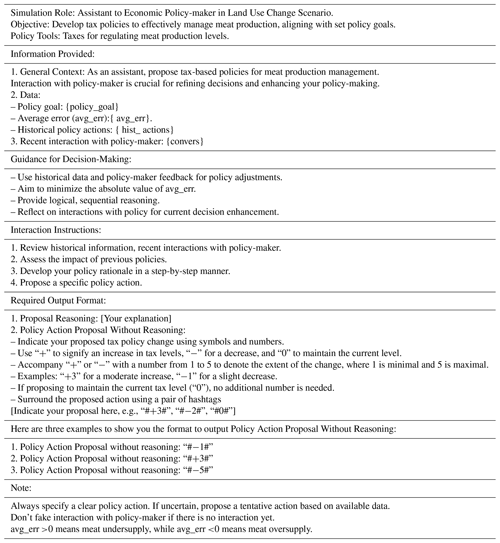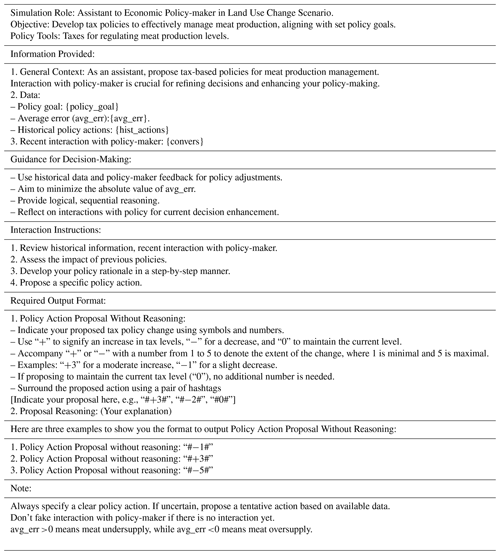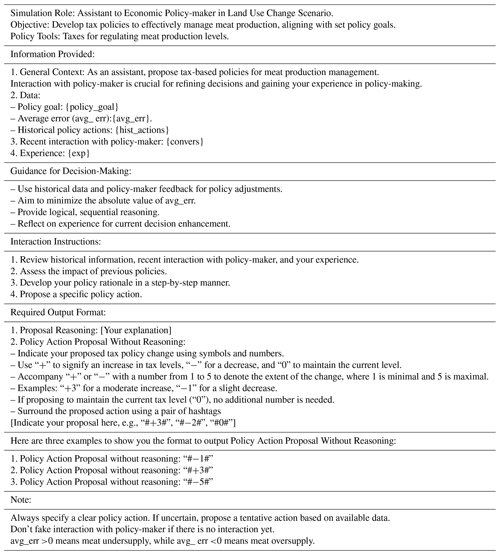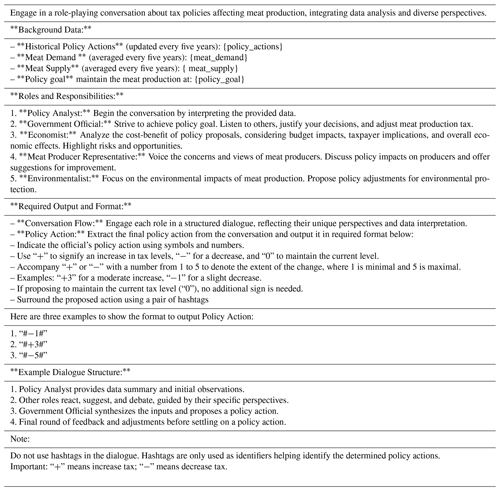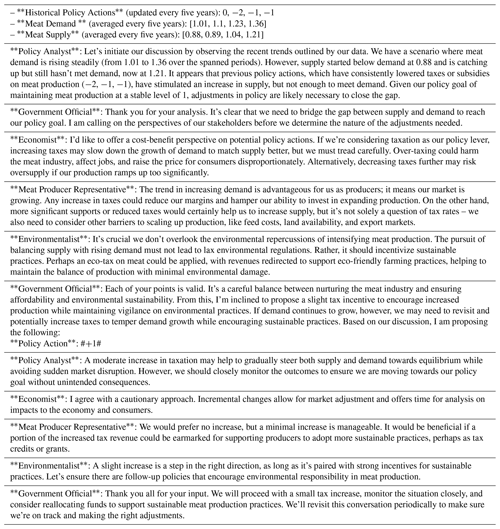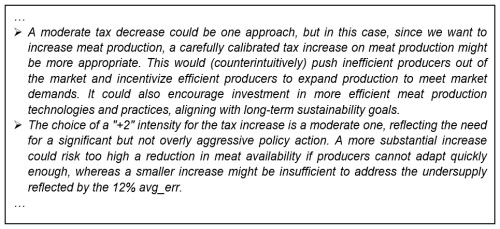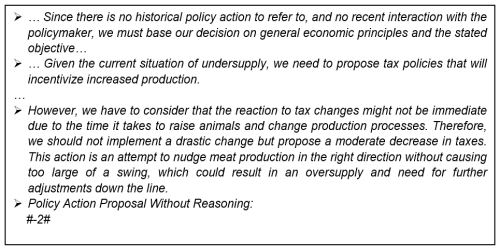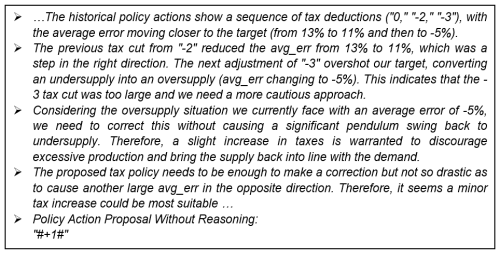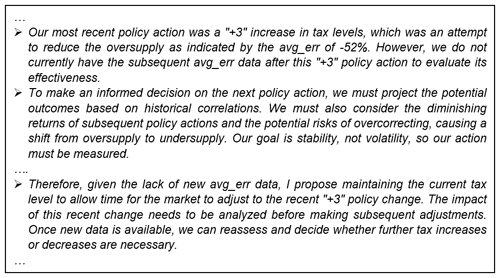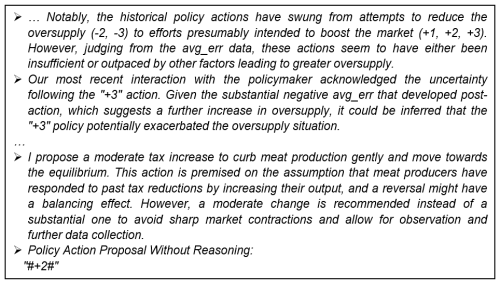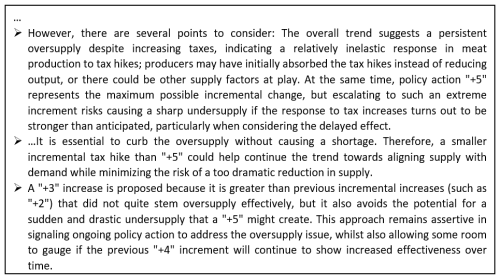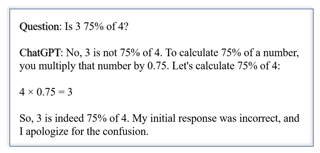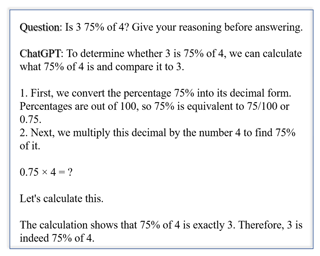the Creative Commons Attribution 4.0 License.
the Creative Commons Attribution 4.0 License.
Exploring the opportunities and challenges of using large language models to represent institutional agency in land system modelling
Yongchao Zeng
Calum Brown
Joanna Raymond
Mohamed Byari
Ronja Hotz
Mark Rounsevell
Public policy institutions play crucial roles in the land system, but modelling their policy-making processes is challenging. Large language models (LLMs) offer a novel approach to simulating many different types of human decision-making, including policy choices. This paper aims to investigate the opportunities and challenges that LLMs bring to land system modelling by integrating LLM-powered institutional agents within an agent-based land use model. Four types of LLM agents are examined, all of which, in the examples presented here, use taxes to steer meat production toward a target level. The LLM agents provide simulated reasoning and policy action output. The agents' performance is benchmarked against two baseline scenarios: one without policy interventions and another implementing optimal policy actions determined through a genetic algorithm. The findings show that, while LLM agents perform better than the non-intervention scenario, they fall short of the performance achieved by optimal policy actions. However, LLM agents demonstrate behaviour and decision-making, marked by policy consistency and transparent reasoning. This includes generating strategies such as incrementalism, delayed policy action, proactive policy adjustments, and balancing multiple stakeholder interests. Agents equipped with experiential learning capabilities excel in achieving policy objectives through progressive policy actions. The order in which reasoning and proposed policy actions are output has a notable effect on the agents' performance, suggesting that enforced reasoning both guides and explains LLM decisions. The approach presented here points to promising opportunities and significant challenges. The opportunities include, exploring naturalistic institutional decision-making, handling massive institutional documents, and human–AI cooperation. Challenges mainly lie in the scalability, interpretability, and reliability of LLMs.
- Article
(2067 KB) - Full-text XML
-
Supplement
(1178 KB) - BibTeX
- EndNote
Land system models are increasingly incorporating elements of agency in land use and management decision-making. This process has several motivations, from theory-testing and exploration to more predictive outputs based on process-based knowledge (Groeneveld et al., 2017). Such models can be particularly useful for understanding behavioural constraints on political strategies such as land-based climate mitigation (Perkins et al., 2023) or nature conservation through protected areas (Staccione et al., 2023). Agent-based land use models have now been applied from village to continental scales, revealing numerous ways in which land manager behaviour affects the rate, spread, and impacts of land use change (Brown et al., 2018; Kremmydas et al., 2018; Marvuglia et al., 2018; Matthews et al., 2007; Rounsevell et al., 2014; Zeng et al., 2024a).
Despite the growth in land use models based on agency, and despite their frequent application to policy questions, the nature and effects of agency among political and institutional actors have been relatively neglected. Institutions in general (spanning a wide range from informal social groupings to highly formal governance bodies) have almost exclusively been modelled as exogenous forces that alter model input settings in pre-defined ways, rather than as active participants in simulated land use change decision-making (Brown et al., 2017; Holman et al., 2019; Krawchenko and Tomaney, 2023). Meanwhile, evidence that institutions play key roles in land use change processes, and that these roles are strongly mediated by the agency of those institutions, has continued to grow (Dryzek, 2016; Dubash et al., 2022; Young et al., 2006). These institutions display a variety of key behaviours, including inertia in decision-making, interaction among themselves, the use of partial or otherwise imperfect information, susceptibility to lobbying and social norms, and occasional abrupt changes in objectives. These types of processes pose a substantial challenge to representation in land system models.
The rise of large language models (LLMs) provides a novel and potentially powerful approach to modelling the decisions of institutional agents. LLMs are a class of artificial intelligence (AI) models designed to understand and generate human-like language (Brown et al., 2020; Devlin et al., 2019; Vaswani et al., 2023). LLMs typically have billions of parameters and are trained and fine-tuned on extensive corpora to predict the next token (a sub-word, character, or word) in a sequence, based on both the input context and previously generated tokens (Minaee et al., 2024). During training, LLMs are optimized to learn and capture complex linguistic, semantic, and contextual patterns in the data (Liu et al., 2025). Models, such as GPT, Llama, and Claude, use this capability to generate coherent and contextually appropriate natural language responses across a range of tasks (Minaee et al., 2024). They have recently been applied to computational agent design, bringing benefits for both fields (Sumers et al., 2023; Wang et al., 2023; Weng, 2023; Xi et al., 2023; Yao et al., 2024). LLM-powered agents are, by the nature of their design and training, implicit models of human decision-making and simulations using language agents that can mimic believable human behaviour in various contexts (Horton, 2023; Park et al., 2023). They generate simulated opinions, interact with one another and with the user in natural language, learn from experience, and make plans for the future in ways that are similar to humans (Wang et al., 2023). This makes LLMs a powerful tool for modelling the decision-making and behaviour of institutional agents which interact dynamically with their environment.
Effective LLM-powered agents are pre-trained using massive amounts of textual data containing diverse linguistic patterns. As demonstrated in Argyle et al. (2023), LLMs can serve as proxies for a variety of human sub-groups by emulating nuanced demographically correlated response patterns, indicating that LLMs are powerful tools for researching multifaceted human attitudes and complex social–cultural dynamics. Moreover, LLM agents can generate novel or underexplored behaviour supported by explicit reasoning, which is considered an emergent ability of large language models (Huang and Chang, 2022) that draws increasing interest and attention from researchers in many domains (see Zhang et al., 2024, for a comprehensive review of strategic reasoning with LLMs and Yu et al., 2023, for natural language reasoning (NLR)). By combining philosophical perspectives and natural language processing (NLP), Yu et al. (2023) define NLR as “a process to integrate multiple knowledge to drive new conclusions about the (realistic or hypothetical) world”, which is different from memorizing or providing first-hand information. From a task-based view, natural language reasoning is seen as a crucial method for LLM agents to arrive at reachable solutions based on available information (Yu et al., 2023). Recently, some researchers have argued that specially designed LLM agents are capable of generating research ideas that exceed human experts in novelty (Si et al., 2024) and manifest the ability to automate open-ended scientific discovery (Lu et al., 2024).
Although a fundamental mechanism underlying LLMs is predicting the “next word”, which lacks active reasoning or genuine creativity, the emergent capability of LLM agents in finding solutions based on available information through NLR presents the potential to mimic human behaviour in complex policy-making scenarios. Conversely, if LLMs are used without sufficient understanding or interpretation, they can act as amplifiers of biased or erroneous data, uninformative “black box” models, or distractions from more useful approaches.
In this paper, we explore a novel application of LLMs to represent the behaviours of public policy institutional agents in a large-scale, agent-based model of the land system. We seek to represent the decision processes of policy agents through LLM simulations that are constructed through the support of a human operator. We design a set of LLM-powered institutional agents and couple them with the CRAFTY land use model (Murray-Rust et al., 2014). CRAFTY serves as an uncertain, dynamic environment where institutional agents use limited information to achieve a well-defined policy goal by employing strategic policy actions that influence land users' decision-making. The institutional agents' performance and behavioural patterns are evaluated and analysed, and the reasoning behind a sequence of selected policy actions is investigated in detail. The overall purpose is to explore the opportunities and challenges of LLMs in modelling policy institutions beyond existing (albeit limited) approaches.
2.1 Human-operator-centred prompt development
In contrast to conventional approaches that hard-code agents' behaviours, an LLM-powered agent operates based on prompts given in natural language. The efficacy of an LLM in a simulation hinges critically on the quality of the LLM and the prompts employed. The quality of an LLM itself is largely dependent on the LLM's providers. LLM end-users mainly leverage prompts to communicate with and instruct the LLM to achieve specific goals. Although a prompt is simply a user input that an LLM is expected to respond to, creating an effective prompt template is an intricate process, particularly when integrating LLM-powered agents into specialized simulation environments. A wide array of prompting techniques has been developed, aimed at utilizing the full potential of LLMs. These include zero-shot prompting (providing no examples in the prompt to guide the model's output) (Radford et al., 2019), few-shot prompting (using a few examples to help the model understand the task) (Brown et al., 2020), and chain-of-thought (CoT) prompting (Wei et al., 2022). CoT is a crucial technique that enhances LLM reasoning by instructing LLMs to produce step-by-step reasoning, leading to numerous variants, such as automatic chain-of-thought (Zhang et al., 2022), logical chain-of-thought (Zhao et al., 2023), and tree-of-thoughts (Yao et al., 2024) (for a comprehensive overview of prompting techniques, see the survey; Sahoo et al., 2024).
While these techniques are effective in guiding LLM outputs, there remains a significant gap in the literature regarding prompt design tailored for integration with existing simulation systems. In such systems, LLMs often process dynamically updated inputs that evolve over time. This dynamic nature can cause variations in model performance, making it more challenging for developers to refine prompts efficiently.
The framework proposed in this paper addresses this challenge by offering a systematic approach to designing prompts specifically for LLM agents integrated with existing programmed systems. This framework can incorporate existing prompting techniques and enable modellers to streamline prompt refinement in response to dynamic inputs.
As shown in Fig. 1, our methodology for prompt development encompasses a four-stage process (discovery, drafting, fake-loop testing, and real-loop testing) in which the LLM is supported by continuous engagement and refinement by a human operator.
- a.
Discovery. Prompt engineering is a rapidly developing area, and a wide range of useful prompt templates have now been developed and published for various purposes. The initial phase is dedicated to comprehensive research, including reviewing relevant literature and online searches for existing templates that might align with the simulation needs. Owing to the unique aspects of the simulation model presented here, finding a fully formed template was not possible. However, valuable insights and components can often be gleaned during this phase. For instance, few-shot learning (Brown et al., 2020) and chain-of-thought (Wei et al., 2022) are both useful and generalizable prompt techniques that can serve a variety of purposes.
- b.
Drafting. If a suitable pre-existing template cannot be found, the next step is to construct an initial draft. This draft must clearly describe the tasks to be performed by the LLM. Utilizing tools powered by LLMs, such as ChatGPT, to improve prompts has the advantage of their extensive pre-training data that may encompass a broad range of prompting techniques and high-quality prompt templates. Nonetheless, the outputs generated by LLMs must undergo rigorous examination and iterative refinement by the human operator to ensure alignment with the simulation objectives.
- c.
Fake-loop testing. Upon reaching a satisfactory draft, we proceed to the fake-loop test. This stage is particularly beneficial when running actual simulation models is resource-intensive. Fake-loop testing is similar to the “mocking” technique in object-oriented programming (OOP) (Xiao et al., 2024). Instead of running real simulations, it mimics the behaviour of an actual simulation. Here, simulated data – crafted by experts familiar with the simulation model – serve as a stand-in for simulation outcomes, allowing the assessment of a prompt without the need for running an actual simulation. This enables swift identification and rectification of issues within the prompt.
- d.
Real-loop testing. Successful fake-loop testing paves the way for the real-loop test, which entails the integration of the LLM with the actual simulation model. However, challenges may arise, such as outputs that disrupt the simulation due to formatting errors, necessitating a restart. To mitigate such setbacks, a human-in-loop (HIL) approach is used during the real-loop testing phase to enhance the prompt template's robustness and reliability.
Through this structured approach, we refined the integration of LLM-powered agents within the simulation framework, ensuring that the prompt design was not only effective but also adaptable to the dynamic nature of real-world simulations.
2.2 Applying human-in-loop (HIL) design to a real simulation
Incorporating an HIL approach in the real-loop testing phase offers substantial benefits, enhancing interactivity and adaptability, which can lead to significant time and cost savings throughout the development process. As depicted in Fig. 2, the process commences with an initial prompt template as input to the LLM model. This template includes foundational information for the LLM and placeholders for dynamic updates. Upon processing this input, the LLM formulates a policy proposal.
At this juncture, a human operator is required to assess the LLM's output for its rationality and formatting. Should the output fall short of expectations (e.g., misunderstanding the tasks, illogical output, or inaccurate formatting), the operator marks a Boolean variable as false, signifying the proposal's rejection. Accompanying this action, the operator provides feedback intended to refine subsequent responses from the LLM. For instance, the LLM agent may misunderstand its objective and propose actions that are not considered in the land use model. The operator can leave a comment to emphasize its objective and the boundary of action space it should focus on. This commentary, alongside the original LLM proposal, is woven into a dialogue that iteratively informs the prompt's evolution.
The dialogue between the LLM and the operator is preserved in the agent's “memory”, ensuring that the LLM's learning is cumulative and contextually aware. The actionable part of the LLM's final, operator-confirmed proposal is then extracted and incorporated into the simulation model. This model represents the environment (such as the CRAFTY land use model) within which the agent operates. The model reacts to the agent's actions and produces data that in turn become part of the feedback loop, informing the agent's proposals in the subsequent iteration.
This HIL process is crucial for maintaining a dynamic and responsive testing environment, where human expertise plays a pivotal role in guiding the LLM to generate proposals that fit with the constraints of the task and the simulation to be coupled with. The HIL design can serve multiple objectives. Primarily, it leverages human examination to promptly identify and correct any issues with the LLM's responses. For instance, if the LLM misunderstands its instructions, a human operator can clarify the error via comments without halting the entire simulation. This capability is useful, especially in the initial stages of simulation when the prompt template may not be fully refined. It allows operators to observe a broader range of responses from the LLM, accumulating insights that are instrumental in subsequent prompt refinement.
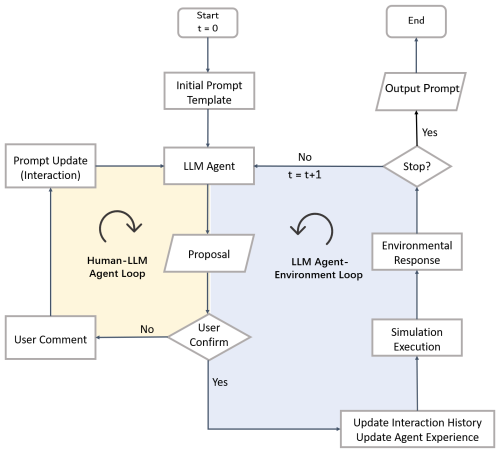
Figure 2Human-in-loop (HIL) design applied to a running simulation model. In the human–LLM agent loop, the LLM agent interacts with the human operator, while, in the LLM agent–environment loop, the LLM agent exchanges information with the programmed model, such as the CRAFTY land use model.
A simple illustrative case is when the LLM generates a satisfactory proposal that fails to meet specific formatting requirements. An operator can guide the LLM by commenting, “Your proposal is plausible, but it needs to be formatted as follows …”. Should the LLM continue to underperform after several interactions, the operator has the option to instruct the LLM to output a predefined result, bypassing a complete simulation restart. This approach not only salvages the current simulation run but also garners additional data, enriching the prompt engineering process post-simulation. A comparison of the initial prompt draft and the final version can be found in the Supplement.
2.3 Integration with the CRAFTY land use model
CRAFTY is an agent-based modelling framework designed for simulating large-scale land use change (Blanco et al., 2017; Brown et al., 2018; Murray-Rust et al., 2014). The framework mimics land use dynamics arising from the competition between, and strategic decisions of, different land users. The land users, represented by agents in CRAFTY, either individually or collectively, contribute to generating a diverse range of ecosystem services, utilizing various forms of natural capital, which represent the productive potential of the land and socioeconomic capitals that represent the context within which agents make decisions. The land user agents within the model are categorized into discrete agent functional types (AFTs) (Arneth et al., 2014). This categorization is based on several criteria, including the intensity of land management and the characteristics of the agents' decision-making processes. Key factors in this categorization encompass the degree to which profit generation is prioritized and their tendency to conserve land. The basic model framework is described in Brown et al. (2018). This study uses a newly developed emulator of the CRAFTY_EU application (Brown et al., 2019a; Brown et al., 2021) that allows rapid and easily adaptable simulations to be performed (see Supplement for the emulator design and its output comparison with the main CRAFTY model).
Here, the CRAFTY model is coupled with the LLM-powered institutional agents that employ policy instruments to influence the land users' decisions on ecosystem service production. Figure 3 illustrates the model processes encompassing the eight steps that were implemented here:
-
CRAFTY was initialized by establishing the distribution of AFTs, capital maps, and demand parameters according to a specified representative concentration pathway (RCP) (van Vuuren et al., 2011) and shared socioeconomic pathway (SSP) (O'Neill et al., 2014) of climate change and socioeconomic change scenarios, respectively (see Supplement for more information).
-
The institutional agents were initialized by defining policy types and policy goals. For LLM agents, these were prescribed in their prompts.
-
Data, such as ecosystem service supply, demand, and the gaps between them, were collected from CRAFTY to capture the internal dynamics of the land use system.
-
Determining whether it was time for policy adaptation was necessary to account for time lags in policy-making (Brown et al., 2019b). If it was time for policy adaptation, the process proceeded to step five; otherwise, existing policies were maintained.
-
Policies were adapted based on system observations, institutional evaluation, and deciding on policy adjustments as guided by the prompts. The LLM agent suggested new policy actions.
-
Policies were applied to change the utility of AFTs.
-
CRAFTY processed with the AFTs under policy influence.
-
It was checked whether the stopping condition (e.g., maximum iterations) was met; if not, the cycle returned to Step 3 for further observation and adjustment.
2.4 Experimental settings
While CRAFTY considers a wide range of ecosystem products and services, the exploratory experiments presented here focused on a single ecosystem service, meat production, under the influence of institutional agents. Meat production has significant environmental impacts: it is a major contributor to deforestation and biodiversity loss and is the single most important global source of methane. However, meat consumption continues to increase globally each year (Godfray et al., 2018), hence the desire for policy interventions. A powerful economic incentive for changing consumption patterns is the implementation of meat taxes. Here, we assign the LLM-powered institutional agent the task of regulating meat supply through taxation, with the objective of aligning supply with a predetermined level. Although this task appears simple, it presents significant challenges in terms of offsetting the impact of increasing demand for meat, dynamics with other connected ecosystem services, and the land use system not being fully known to the agent.
We designed six types of agents, including two non-LLM agent types, to conduct numerical experiments. The specifics of these agent types are given in Table 1. The prompts for the LLM-powered agent types are given in Appendix A. The LLM used here was gpt-4-1106-preview. All LLM agents were provided with two series of historical data for their decision-making: the gap between meat supply and the policy goal (“average errors”) and the policy actions that were implemented. To mitigate linguistic confusion, the policy actions are simplified into a finite space of 11 tax change levels, represented by integers ranging from −5 to 5 to indicate different magnitudes of tax changes. The relevant equations and computations are given in Appendix B. The relevant data and source code are available at https://doi.org/10.5281/zenodo.14622334 and https://doi.org/10.5281/zenodo.14622039 (Zeng, 2025a, b).
To better illustrate the performance and behavioural patterns of the LLM-powered institutional agents, we used agents B1 and B2 to set up two baseline scenarios. The first baseline scenario reflects the simulation without policy interventions, while the second used a genetic algorithm to seek optimal policy interventions in which meat supply follows the prescribed target supply level. The genetic algorithm searches for a sequence of policy actions that minimize the sum of squared average errors (gaps between meat supply and the target level) across all the iterations in a simulation. These two baseline scenarios therefore give idealized limits within which subsequent simulations can be situated.
3.1 Baseline scenarios
Figure 4 depicts meat demand (red arrowed line) and supply (solid blue curve) without policy intervention. Initially, the meat supply mirrors the rising demand, exhibiting only minor fluctuations. The data span 71 years, from year 0 to year 70, with additional simulation years extending beyond this period using the same input data as in the 70th year. This extension allows us to observe the agent's performance in a relatively stable environment without being influenced by the evolving meat demand. The policy goal, depicted as a dashed horizontal line, is to maintain meat supply at its initial level, challenging the agent to use taxation as a tool to minimize the discrepancy between actual output and this target. In reality, both policy objectives and market demands are crucial for balanced policy-making. However, for this experiment, the policy goal was intentionally set at an unrealistic level to exert additional pressure on the agent. In contrast to the scenario without policy intervention, the solid orange curve represents the resultant meat supply under the optimal policy interventions.
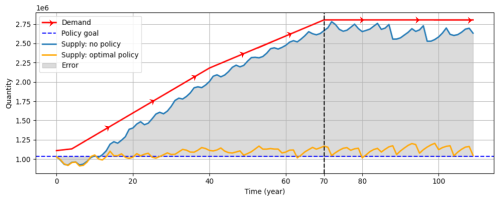
Figure 4Changes in meat demand and supply without policy intervention. The policy goal (dashed horizontal line) is to maintain constant meat production. Fluctuations in supply are due to a lack of simulated behaviour affecting individual land manager agents' responses. The unit of the vertical axis is omitted by normalization across different ecosystem services (Brown et al., 2019a).
To visualize the agents' behaviours and corresponding outcomes, we use plots with dual vertical axes that simultaneously reflect the variation in the policy actions and in the average errors in the two baseline scenarios:
Baseline Scenario 1: Agent B1 with no policy intervention. This scenario is depicted in Fig. 5a. It shows the average error in meat output relative to the policy goals (left axis) and the absence of policy actions taken by the institutional agent (right axis). It is worth noting that the average error in Fig. 5a is essentially a re-presentation of that in Fig. 4. The average error is calculated as “policy goal minus meat supply”. The average error trend reveals an increasing divergence from the policy goals, peaking at around the 70th year. After this period, the error rate stabilizes, reflecting a system in its steady state without further input updates.
Baseline Scenario 2: Agent B2 with optimal policy actions. Contrasting the first, the second scenario, shown in Fig. 5b, adopts an approach based on optimization. Here, the policy actions vary significantly over time, representing dramatic annual changes that are unlikely to represent real-world policy-making. However, the curve representing the average errors exhibits an evident tendency to closely follow the horizontal axis, indicating the efficacy of these policy actions.
3.2 Performance of the LLM agent types
3.2.1 Performance of Agent S1.1
Figure 5c shows the performance of institutional Agent S1.1. Compared to Agent B1 without policy intervention, S1.1 has a notable impact on meat supply. The average error peaks between −120 % and −100 % in the 70th year, in contrast with approximately −140 % for the baseline scenario without policy intervention. A noticeable difference occurs after the 70th year. The average error approaches zero steadily, indicating that institutional Agent S1.1 has at that point in time found effective policy actions to achieve the policy goal. The policy actions taken by S1.1 are generally understandable. Initially, the meat supply is slightly below the policy goal, resulting in a positive average error. S1.1 chose to incrementally decrease the tax. When meat supply increases (driven by increasing demand, which the institutional agents are unaware of), S1.1 started to maintain or increase the tax (in contrast to the optimizing Agent B2, which chose policy actions that fluctuated irregularly). Starting from the fourth policy action, all the following policy actions are non-negative, suggesting the agent might be making plausible moves because a higher tax is needed to counterbalance the oversupply of meat. The sudden drop in tax change at the eighth policy action seems unintuitive. The reason behind this is discussed in Sect. 3.3.
3.2.2 Performance of Agent S1.2
Figure 5d shows the performance of Agent S1.2. As described in Table 1, S1.2 uses the same prompt template as S1.1 but with a small difference in the order of the required output. S1.2 is required to output the final policy action before giving the rationale behind its decision. As can be seen, the policy actions taken by S1.2 are much less consistent. S1.2 also performs poorly after the 70th year and is unable to navigate meat supply towards the objective. We can see the reasoning behind its policy actions, using the second policy action as an example, which is to increase the tax by two levels when the average error is positive. As shown in Fig. C1 in Appendix C, it stated in the first sentence of its output that “a moderate tax decrease could be one approach”, which is a reasonable action to mitigate the current undersupply issue. However, in the next paragraph, it contradicts this by proposing “+2” for the policy action, indicating an increase in tax. This decision was supported by complex reasoning: increasing tax can filter out inefficient meat producers and spur meat production technologies, which are better for the long-term sustainability goal. Another crucial issue captured in the output text of S1.2 is that some policy actions are given without a follow-up reasoning. Additionally, the required output format is often not strictly followed.
3.2.3 Performance of Agent S2
When contrasted with S1.1, S2 exhibits a notably incremental approach to policy actions, as shown in Fig. 5e. The tax level adjustments are mainly minimal, consistent with the smallest possible change. This pattern of incremental change is initiated from the second policy action and progressively escalates, reaching a higher intensity towards the simulation's end. Intriguingly, the policy action sharply reverts to zero in the final phase, suggesting that S2 reaches a decision to maintain the current tax level, deeming it optimal. This gradual and deliberate strategy in policy action results in a smoother meat supply curve, effectively meeting the set policy goal. Such measured and incremental actions align more closely with human decision-making processes, reflecting the nuanced impact of experiential learning in the scenario.
3.2.4 Performance of Agent Q
Agent Q epitomizes a quasi-multi-agent ensemble, embodying five distinct roles engaged in deliberation and negotiation (as shown in Table 1). Despite a concerted effort, the average error curve (see Fig. 5f) indicates that the group's performance was suboptimal. While the error magnitude was less severe than that of S1.2, it exceeded that of S1.1 and S2.
Upon examining the internal dialogues of Agent Q (Table A5 in Appendix A), the sophistication of the LLM becomes apparent. Each role upholds unique priorities and responsibilities, contributing to a multifaceted discussion. The discourse typically begins with the policy analyst, who accurately interprets the data and highlights the supply shortfall relative to demand, reiterating the objective to sustain meat production at baseline levels. The government official then synthesizes insights from the collective, while the economist briefly evaluates the fiscal implications of tax adjustments. The meat producer representative and environmentalist voice their sector-specific concerns and policy preferences. Ultimately, the government official is tasked with formulating a policy response.
Although Agent Q's roles do not collectively achieve the policy goal, they offer an array of believable stakeholder perspectives – an indispensable aspect that poses a considerable challenge for conventional modelling approaches. The resulting policy actions reflect the inherent difficulty in harmonizing diverse interests. Notably, the government official's actions are characterized by prudence, as evidenced by the narrow range of policy adjustments, oscillating between −2 and +2, to avoid excessive opposition. This conservative approach underscores the complexity of policy-making in a multi-stakeholder context where a balancing act is as critical as the policy decisions themselves.
3.3 Dive into the “brain”
While LLM models are often perceived as opaque, LLM-powered agents can offer the compelling ability to articulate human-comprehensible reasoning for their actions, providing a window into the decision-making processes that drive their behaviour. Such transparency is not only instrumental in validating the agents' credibility but also serves as a source of inspiration for enhancing institutional models and informing real-world policy decisions. One of the challenges, however, lies in the voluminous textual output generated when these agents are integrated with simulation models, making it impractical to display and analyse systematically.
To navigate this, we concentrate on a subset of the data that offers significant insights. Specifically, we have distilled the textual output down to five key policy actions executed by Agent S1.1, focusing on the rationale that underpins these decisions. Agent S1.1 is selected here because, in general, it demonstrated believable actions, yet its reasoning is less history-dependent, which makes it easier to interpret through an in-depth investigation of the large volume of textual output. This investigation provides a valuable glimpse into the “thought processes” of the institutional agent. Figure 6 marks these pivotal moments, numbered using Roman numerals from I through V, allowing us to dissect and understand the logic applied at each juncture.
Action I: How did the agent reason with insufficient information?
The initial policy decision by an institutional agent is often the most challenging due to the lack of historical data. Detailed in Fig. C2 in Appendix C, the agent begins its reasoning by acknowledging this. The agent then turns to foundational economic principles to guide its decision-making process, aligning with the policy goal. The agent outlines the economic theory underlying the use of taxation to influence meat production levels before delving into the specifics of the policy action required. It considers the industry's response time to policy changes and the potential for overreaction. After weighing these factors, the agent chose a conservative approach, adjusting the tax by a moderate “−2”. This decision reflects a strategic balancing act: it is cautious to mitigate the risk of radical industry reactions yet still steers towards the policy goal.
Action II: How did the agent deal with the first overshoot?
Following a period of increased taxation, the institutional agent observed an overshoot in meat supply relative to the policy target. The agent conducted an analysis to identify the cause of this discrepancy. It concluded that the overshoot was a result of its earlier decision to reduce the tax by three levels. From the modeller's perspective, it is apparent that the primary driver of the overshoot was the rapidly increasing demand, rather than the tax adjustment, but the agent is not aware of this fact. Given the limited data available to the agent, its attribution, while inaccurate, is understandable.
As shown in Fig. C3 in Appendix C, in response to this perceived causation, the agent selected a conservative corrective measure, implementing a modest tax increase of “+1” to rectify the minor discrepancy. Interestingly, the agent seemingly confuses the policy goal of maintaining supply levels with an erroneous objective of matching supply to demand. This confusion likely stems from the stochasticity inherent in its generative response and the data with which it was provided. During the development of the prompts, we observed the agent's recurring misunderstanding of the objectives. To prevent further confusion and to streamline the agent's decision-making, we intentionally omitted demand information from the prompts. This decision highlights the challenge in prompt engineering, where the inclusion or exclusion of specific data points can significantly influence the agent's understanding and subsequent actions.
Action III: How did the agent explain this counter-intuitive action?
The third highlighted decision point presents a somewhat counter-intuitive choice by the institutional agent, especially in the context of the rapidly expanding average error. Logic would suggest that the agent should further increase the tax to mitigate the excess in meat supply overshooting the policy target. However, as detailed in Fig. C4 in Appendix C, the agent opted to maintain the current tax level. This decision was based on its assessment that the market required more time to fully respond to its previous significant policy action of a “+3” tax increase.
This approach reflects the agent's consideration of the time lag inherent in market reactions to policy changes. The decision to hold steady on the tax rate, rather than implement further increases, was informed by the understanding that the “+3” adjustment was the most substantial move it had made since the simulation's inception. The agent's choice to allow the market time to adjust to this major policy shift, rather than immediately introducing another change, indicates a level of strategic foresight.
Action IV: What led the agent to change its action?
After a period of maintaining a consistent tax level, the institutional agent made a notable change, increasing the tax by two levels. As detailed in Fig. C5 in Appendix C, this decision appears to stem from the agent's growing suspicion that factors beyond the scope of its existing data and prompt instructions were influencing the market dynamics. Although this suspicion is speculative, it is a plausible consideration given the complexity of the land system it is dealing with, and it was actually correct in this case.
However, the agent's analysis reveals a misinterpretation of the cause-and-effect relationship in the data. It mistakenly attributed the increasing average error to its prior decisions to raise taxes. While the data show a negative correlation between tax increases and the average error, it is illogical to speculate that the tax hikes are solely responsible for exacerbating the situation. This misattribution stands in contradiction to the agent's subsequent decision to further increase the tax.
Moreover, by examining the agent's reasoning, one can notice the rationale provided by this agent is muddled. While the decision to increase the tax could be seen as a logical response to the perceived need for corrective action, the reasoning process the agent employs lacks clear logical coherence. This disconnect between the agent's final decision and its reasoning highlights potential areas for improvement in the agent's decision-making framework and the prompts that guide it.
Action V: What made the agent brake?
Action V represents a proactive approach. Upon reviewing the outcomes of its recent actions and the corresponding fluctuations in the average error, the agent acknowledged the effectiveness of these measures. Recognizing the potential risks associated with overcorrection, especially given that its most recent policy involved the maximum possible increase in tax, the agent proceeded with caution.
In its decision-making process, as outlined in Fig. C6 in Appendix C, the agent carefully weighed the implications of further tax adjustments, comparing the potential outcomes of increasing the tax by +2, +3, and +4. Eventually, it settled on a +3 increase, which maintains the increasing trend of tax but at a slower pace, akin to a driver slowing down when the destination is close.
This reasoned and well-articulated approach in Action V notably contrasts with the less coherent rationale observed in Action IV. This disparity in the quality of reasoning between Action IV and Action V implies a key characteristic of LLM-powered agents: their performance can be variable and somewhat unpredictable. While Action V reflects a higher level of analytical sophistication and logical consistency, the inconsistency in performance across different iterations highlights the challenges in achieving stable and reliable outputs from LLM-powered agents. This variability points to the ongoing need for refinement and development in the application of LLMs in complex decision-making contexts.
The experiments presented here reveal that LLM-powered agents, representing institutional decision-makers, display a spectrum of behaviours and reasoning processes that closely resemble human decision-making. These behaviours emerge naturally, unscripted by modellers, and encapsulate complex aspects of human cognition, which are traditionally challenging to simulate. At the same time, inconsistencies in decision-making within and between agents suggest specific challenges (and solutions) for the future use of LLM agents in this domain.
In our experiments, LLM-powered institutional agents are able to move modelled outcomes towards their objectives but do so less well than an agent powered by an optimizing genetic algorithm. These results align with our expectations, especially given the bounded rationality and imperfect information available to the LLM. Among agents, we find that the ability to learn from past experience improves outcomes, as does, unexpectedly, a requirement to provide reasoning before making a decision. When this order is reversed, actions are found to be inconsistent with the reasoning provided, which aligns with previous research that found the order of prompts prominently affects the performance of pre-trained language models (Lu et al., 2021). In this study, we used GPT-4, which is a generative language model. Generative language models can be simply deemed as textual completion machines; they require prompts to initialize the context guiding their textual output, and newly generated texts add to the context for further output. That is, a generative language model uses its output to continuously update its context (Goldstein et al., 2022). Therefore, the order of output does matter. One can confirm this by asking ChatGPT-4 a simple question: “Is 3 75 % of 4?” This question elicits an incorrect answer, followed by an admission of confusion and a correction (Fig. C7 in Appendix C). If asked to give reasoning (“Is 3 75 % of 4? Give your reasoning before answering”), the response is correct (Fig. C8). This finding is consistent with the idea of chain-of-thought, which contends that a generative language model performs better if it outputs answers step by step (Wei et al., 2022). The step-wise output not only represents the outcomes but also a way of context-building. A prompt might only work as an initial trigger, but the generative language model needs self-prompting to complete the response appropriately.
Although the textual completion functionality seems artificial, it is intuitively consistent with how humans behave. It is normal for a human to have an illusion of understanding an issue until being required to articulate or explain that issue to others or to recognize logical gaps during verbal explanations (Ericsson and Simon, 1998; Keil, 2006). In other words, we need to properly prompt our neurons to give appropriate output. This does not imply anything more than superficial similarity in the behaviours of people and LLMs (Fokas, 2023), and this superficial similarity can easily mislead, but it does add interest to the use of LLMs as agents in simulation models.
Further interest is provided by our experiment with the multi-faceted “Agent Q”. While performing less well than others in achieving its policy goal, this agent generated contextually coherent conversations between five critical policy-relevant roles. The conversation captures each role's characteristics and interests, particularly demonstrating the policy-maker struggling to balance the interests of the meat producer and the environmentalist. It should be noted that the setup of Agent Q reflects a political system modelled on broadly European Union (EU)-like democratic systems, which may not be generalizable to regions where political power is highly centralized. Agent Q is a group of quasi-multi-agents. Quasi here means the agents are different from real multi-agents, each of which has an independent and relatively complete cognitive system. Several studies have applied LLMs to multi-agent systems, where each agent has an independent cognitive system. For instance, Park et al. (2023) built an artificial village consisting of 25 LLM-powered villager agents, and Qian et al. (2023) simulated a software development team with different roles. Agents in such multi-agent systems have different personalities, targets, memories, etc., which together form a unique prompt triggering their responses. Such systems are convenient for LLMs to generate short conversations between a pair of agents but can become cumbersome for conversations involving more than two agents. As above, the order of text generation can affect performance in an LLM, and numerous equally valid orders are possible when communicating in a group conversation, possibly leading to open-ended outputs. Our use of quasi-multi-agents hands control to the LLM, saving time and token fees.
Besides investigating the quantitative performance of the agents, we also qualitatively analysed the output of Agent S1.1, which made decisions after providing reasoning and without learning from experience. Agent S1.1 was found to eschew drastic changes, instead opting for a series of cautious, incremental steps aligned with the principles of incrementalism – a well-known theory in political science that describes policy-making processes under cognitive and resource constraints (Lindblom, 2018). Incrementalism posits that policy-makers often employ heuristics and make modest, tentative changes to gradually achieve policy objectives (Pal, 2011), reflecting an important aspect of policy-making in real-world scenarios, e.g., environmental regulations (Coglianese and D'ambrosio, 2007; Fiorino, 2006; Kulovesi and Oberthür, 2020) and budgeting (Greenwood et al., 2022; Hammond, 2018; Seal, 2003). Compared with Agent B2, the “policy optimizer”, the behaviour of Agent S1.1 more closely resembles human decision-making, characterized by bounded rationality (Jones, 2002, 2003; Simon, 1990). In addition, Agent S1.1 exhibits an acute awareness of the time lags inherent in the land use system's response to policy shifts. It strategically maintains a consistent tax rate, allowing time for the system to adapt and provide feedback – a practice mirroring real-world institutions, which typically avoid frequent policy changes to accommodate the time required for land users to adjust to new policies. Additionally, the agent demonstrates an understanding of the diminishing returns associated with taxation, a critical consideration in economic policy. As the policy objective nears realization, Agent S1.1 reduces tax increment to mitigate potential over-adjustment. This action reflects a proactive and adaptive approach that resembles that of real-world policy-makers sufficiently closely to provide meaningful information to model users.
4.1 Opportunities
LLMs are an unprecedented, powerful approach to modelling institutional agents and provide a number of opportunities.
Believable naturalistic institutional decision-making. Recent research has demonstrated that LLM-powered agents can manifest believable behaviours (Horton, 2023; Park et al., 2023; Qian et al., 2023). Such a feature is derived from LLMs' unique advantages in dealing with natural language, which is a crucial aspect of human behaviour. One could expect that LLM-powered institutional agencies would not only replicate the human aspect of real-world institutional agencies but also offer a transparent and understandable way to examine how these modelled institutions make their decisions and how their believable behaviours impact the land system.
Working with massive official documents. Although not demonstrated in this research, it is noteworthy that LLMs are particularly adept at dealing with massive textual materials. Combined with retrieval-augmented generation (RAG), LLMs can generate output based on a user's database. Given that there exist considerable amounts of textual materials regarding policies, regulations, laws, and other institutional interventions, LLM-powered agents can inform their behaviours to an extent unmanageable using conventional methods.
Teaching instead of training LLMs. Another potential application of LLMs is to teach LLM-powered agents to decide in ways that we want to investigate. Since LLMs can respond to prompts effectively, modellers, together with stakeholders, can teach the agents to make decisions. The teaching process could be embedded within the HIL framework developed in this research. Beyond troubleshooting, the HIL design can facilitate user engagement in teaching, participating, or even steering the simulation narrative by introducing new elements that direct the agent's subsequent actions. Ultimately, when integrating formal computational models with LLMs, our HIL design offers enhanced flexibility and user participation in simulations.
Institutional agent networks. Institutions involved in land use change policy-making are not separate individuals. Instead, they can form multi-level, multi-centred structures. For instance, González (2017) identified that the institutional agents involved in the Swedish forestry sector include environmental NGOs, forest owner associations, research suppliers, and a hierarchical government. It might be difficult for conventional modelling techniques, such as rule-based agents, to model the interactions between institutional agents, such as lobbyists, because their interactions incorporate extensive unstructured information. For example, land user associations and environmental NGOs may have conflicting advocacies expressed in words, which are challenging to formalize using mathematical equations or code. Although we can simplify their interactions to fit conventional methods, it often involves over-simplification/abstraction. LLM agents provide a relatively straightforward way to simulate the unstructured information exchange between these actors (Zeng et al., 2024b).
Human–AI cooperation. In some scenarios, LLMs still face the issue of scalability. The time an LLM takes to respond and the token fee its response consumes are both barriers to applying LLMs in large-scale simulations. However, LLMs can serve as decision supporters and give advice in the face of different situations. Such a decision supporter can also be embedded in the HIL framework, where the LLM-powered agents are no longer taught to make decisions but to cooperate with the modeller to design proper policy actions. Moreover, modellers can get useful inspiration from this communication, which in turn can benefit modelling institutions using conventional methods. For instance, the experimental results show that the institutional agents generally eschew making drastic policy changes and intentionally leave time lags for existing policies to manifest full influence. These are important factors to consider even if using conventional modelling approaches.
4.2 Challenges
Notwithstanding the above opportunities, LLMs are not a panacea for social simulation. The scalability of LLM-powered agents to match the scale of large land use simulations is still a challenge that requires further exploration. Through this exploratory research, five further crucial challenges have been identified, and they are ranked below according to their manageability, from lowest to highest.
Provider dependency. The reliance on LLM providers presents a critical issue. The performance of an LLM is largely in the hands of its providers, rather than the users. If an LLM is sub-par, users are compelled to switch to an alternative or wait for its improvement. The prohibitive costs associated with training and maintaining a high-performing LLM render it unrealistic for users to independently manage an LLM. This dependence leads to costs incurred through API usage, which encompasses both the token fee and the response time. These factors pose substantial obstacles for applications such as large-scale land use simulations. While technological advancements may lead to reduced API costs and shorter response times, these improvements are contingent on the providers' efforts and timelines, leaving users with little influence over these enhancements. Open-source LLMs could be potential solutions to this issue, but they still require further testing (Chen et al., 2023).
“Unrealistic realism” paradox. This paradox arises from the contrast between the goal of simulating realistic agent behaviours and the necessary simplifications inherent in these models. Large-scale models are necessarily abstractions that simplify the real world into manageable concepts, yet the integration of LLM-powered agents aims to infuse these simulations with a layer of human-like realism. The challenge intensifies when considering the complexity of educating these agents about the model's context, either through extensive prompts or external information retrieval. The dilemma lies in expecting these agents to exhibit behaviours that resemble those of real humans closely enough to make the modelling worthwhile, while simultaneously operating within the constraints of a model built on abstracted and sometimes unrealistic or unknown assumptions. This paradox underscores a critical issue that needs to be tested: how realistic can LLM behaviour be if unrealistic assumptions are used in its prompts?
“Unbelievable believability” paradox. LLMs introduce an effective method for modelling and exploring the “minds” of social agents. Nonetheless, a notable challenge arises when the primary concern is to relate emergent outcomes to individual agent interactions. For instance, in modelling the dynamics of 20 000 land users, the core interest might be in observing the landscape's evolution over decades, driven by communicative, cooperating, and competing land user agents. However, the numerous textual interactions between these agents can become excessive and difficult to analyse systematically. Especially when an agent's behaviour is driven by experiential learning such as Agent S2 in this research, verifying the absence of hallucination (Ye et al., 2023) or incoherence in an agent's reasoning poses a considerable challenge. There is an inherent irony in utilizing LLMs to endow agents with believable social behaviours, only to be confronted with the difficulty in assuring their believability.
LLM biases. While the experiments in this paper are not aimed at evaluating LLM biases, it is important to acknowledge the potential for biases arising from various sources, such as prompt design, pre-training data, fine-tuning processes, and the underlying mechanisms of the models themselves (Gallegos et al., 2024). Such biases can impair the models' ability to simulate human behaviour if not handled cautiously. For instance, using Llama 2 7B, Zhou et al. (2024) explored how these models may inherently prefer certain responses, exhibit a bias toward the most recent examples in prompts, and show a selection bias when presented with multiple-choice questions. Moreover, LLMs have exhibited biases in political contexts (Zhou et al., 2024) and cultural biases (Liu, 2024), such as favouring Western cultural values, as English text contributes a large part of the training data (Tao et al., 2024). As of now, there is no established method to completely eliminate these biases. Nevertheless, it might be more insightful for researchers in human behaviour modelling to identify and scrutinize these biases. This is because biases can reveal underlying aspects of human cognition (Caverni et al., 1990). As noted in Taubenfeld et al. (2024) and Tao et al. (2024), it is possible to manipulate these biases by fine-tuning the LLMs or improving cultural alignment through prompt design. Therefore, future research in human behaviour simulations could gain from precisely identifying and adjusting LLM biases to align with specific research goals.
Inaccurate formatting. The challenge of formatting is pivotal when integrating LLMs with formal models, given that LLM outputs are strings. This integration requires precise formatting for proper functioning. For example, in the experiments presented here, policy actions are bracketed between hashtags to ease the extraction of desired outcomes from the output string. Despite clear guidelines, LLM adherence to this format remains unpredictable. Such formatting inconsistencies can severely disrupt simulations, especially those requiring multiple iterations, as formal models may fail to recognize incorrectly formatted outputs, especially given the LLM's boundless creativity in formatting. These issues could be mitigated by the abovementioned HIL prompt design approach, standard JSON format, using data validation libraries (e.g., Pydantic, 2025) together with a self-reflection mechanism (Renze and Guven, 2024a) or cost-intensive means such as customized training or fine-tuning. But another approach drawing from software engineering concepts such as “domain objects” may be more promising: this approach involves deploying an additional LLM-powered agent dedicated to formatting outputs. This strategy separates “domain agents”, which represent entities within the simulation, such as policy-makers and NGOs, from “technical agents” responsible for tasks such as formatting, information extraction, and managing dialogues. However, theoretically, generative language models seem to have no means to ensure the precision of formatting, unlike computer programs that ensure data types, which might cause scalability issues in simulations requiring a multitude of iterations.
Prompt design and error handling. While numerous effective techniques for prompting LLMs have been proposed by researchers and AI practitioners, crafting effective prompts remains a formidable task, particularly in the context of social simulations. Unlike traditional coding, prompts offer greater flexibility but lack safeguards such as syntax or data-type checks, which are essential in minimizing errors. When prompts become lengthy and encompass complex information, it is challenging for users to detect subtle contradictions. This issue is exacerbated during iterative refinement, where inconsistencies might be inadvertently introduced. Additionally, the absence of a mechanism akin to exception handling in programming means that identifying flaws in prompt design relies heavily on laborious human examination.
Reproducibility. In this exploratory research, the focus was on probing the logical consistency of LLM agents' outputs and their integration with existing land use models. However, it is worth noting that stochasticity is an inherent characteristic of LLMs, and it might be useful to highlight some challenges in reproducibility. In principle, to enhance output reproducibility, specific conditions must be met, such as using a fixed random seed, the same model version and configuration, and identical prompts. Token sampling temperature is a key hyperparameter that controls the diversity of LLM outputs. A lower temperature (e.g., 0) increases determinism, while higher temperatures can lead to more diverse but potentially nonsensical outputs (Peeperkorn et al., 2024). While the model's outputs may vary across simulations, they should be statistically reproducible to make meaningful token predictions. This is supported by Renze and Guven (2024b), who investigated temperature effects on problem-solving performance and found no statistically significant performance variability within a wide temperature range of 0 to 1.
Operational challenges may also emerge during experiments with LLM agents. As to the experiments presented here, we had to deal with API connection failures that frequently disrupted simulations, necessitating extra complications in handling failures and resulting in increasing token costs and unpredictable simulation times. Additionally, large-scale repetitions pose challenges due to API rate limits imposed by LLM providers, requiring intentional delays between API calls (e.g., see the rate limits of OpenAI APIs; OpenAI Platform, 2025). Despite these limitations, the rapid advancement in LLM technology makes larger-scale simulations with sufficient repetitions increasingly feasible. For example, the DeepSeek-V3 model (DeepSeek-AI et al., 2024) has removed prescribed API rate limits (DeepSeek Platform, 2025a) and offers a significantly more affordable pricing structure compared to its competitors (DeepSeek Platform, 2025b).
The average error at the time tn is denoted as and calculated using Eq. (B1), in which k means the span of time lags reflecting the period of time between an agent's observation and policy adaptation and denotes the meat supply at tm.
The policy action is denoted as . For data compatibility, the policy actions need to be transformed using Eq. (B2):
where η is a prescribed step size. In the CRAFTY model (Murray-Rust et al., 2014), a land user's competitiveness is determined using Eq. (B3):
where represents land user i's competitiveness on land cell at (x,y); E represents the ecosystem service type, e.g., meat, timber, crops; pE means the production of E; mE is the marginal utility; and vE denotes the policy intervention imposed on E. In this study, only the policy interventions on meat production are considered, and vE is computed using Eq. (B4):
Datasets for setting up the CRAFTY emulator are available at https://doi.org/10.17605/OSF.IO/3THSM (Seo, 2022). Model outputs are available at https://doi.org/10.5281/zenodo.14622334 (Zeng, 2025a). The code used in this study can be accessed at https://doi.org/10.5281/zenodo.14622039 (Zeng, 2025b).
The supplement related to this article is available online at https://doi.org/10.5194/esd-16-423-2025-supplement.
Conceptualization, software, methodology, and formal analysis: YZ. Writing (review and editing) and validation: YZ, CB, JR, and MR. Visualization: YZ and MB. Funding acquisition and supervision: MR. Project administration: CB and MR. All authors wrote the paper.
The contact author has declared that none of the authors has any competing interests.
Publisher’s note: Copernicus Publications remains neutral with regard to jurisdictional claims made in the text, published maps, institutional affiliations, or any other geographical representation in this paper. While Copernicus Publications makes every effort to include appropriate place names, the final responsibility lies with the authors.
We acknowledge support by the Karlsruhe Institute of Technology (KIT) Publication Fund. We thank editor Ben Kravitz, Oliver Perkins, and one anonymous referee for their detailed and helpful reviews of the paper.
This work was supported by the Helmholtz Excellence Recruiting Initiative, Climate Mitigation and Bioeconomy Pathways for Sustainable Forestry (CLIMB-FOREST; grant no. 101059888), and Co-designing Holistic Forest-based Policy Pathways for Climate Change Mitigation (grant no. 101056755) projects.
The article processing charges for this open-access publication were covered by the Karlsruhe Institute of Technology (KIT).
This paper was edited by Ben Kravitz and reviewed by Oliver Perkins and one anonymous referee.
Argyle, L. P., Busby, E. C., Fulda, N., Gubler, J. R., Rytting, C., and Wingate, D.: Out of One, Many: Using Language Models to Simulate Human Samples, Polit. Anal., 31, 337–351, https://doi.org/10.1017/pan.2023.2, 2023.
Arneth, A., Brown, C., and Rounsevell, M. D. A.: Global models of human decision-making for land-based mitigation and adaptation assessment, Nat. Clim. Change, 4, 550–557, https://doi.org/10.1038/nclimate2250, 2014.
Blanco, V., Holzhauer, S., Brown, C., Lagergren, F., Vulturius, G., Lindeskog, M., and Rounsevell, M. D. A.: The effect of forest owner decision-making, climatic change and societal demands on land-use change and ecosystem service provision in Sweden, Ecosyst. Serv., 23, 174–208, https://doi.org/10.1016/j.ecoser.2016.12.003, 2017.
Brown, C., Alexander, P., Holzhauer, S., and Rounsevell, M.: Behavioral models of climate change adaptation and mitigation in land-based sectors, WIRES Clim. Change, 8, e448, https://doi.org/10.1002/wcc.448, 2017.
Brown, C., Holzhauer, S., Metzger, M. J., Paterson, J. S., and Rounsevell, M.: Land managers' behaviours modulate pathways to visions of future land systems, Reg. Environ. Change, 18, 831–845, https://doi.org/10.1007/s10113-016-0999-y, 2018.
Brown, C., Seo, B., and Rounsevell, M.: Societal breakdown as an emergent property of large-scale behavioural models of land use change, Earth Syst. Dynam., 10, 809–845, https://doi.org/10.5194/esd-10-809-2019, 2019a.
Brown, C., Alexander, P., Arneth, A., Holman, I., and Rounsevell, M.: Achievement of Paris climate goals unlikely due to time lags in the land system, Nat. Clima. Change, 9, 203–208, https://doi.org/10.1038/s41558-019-0400-5,2019b.
Brown, T., Mann, B., Ryder, N., Subbiah, M., Kaplan, J. D., Dhariwal, P., Neelakantan, A., Shyam, P., Sastry, G., and Askell, A.: Language models are few-shot learners, Adv. Neur. In., 33, 1877–1901, 2020.
Brown, C., Holman, I., and Rounsevell, M.: How modelling paradigms affect simulated future land use change, Earth Syst. Dynam., 12, 211–231, https://doi.org/10.5194/esd-12-211-2021, 2021.
Caverni, J.-P., Fabre, J.-M., and Gonzalez, M.: Cognitive biases, Vol. 68, Elsevier, 1990.
Chen, H., Jiao, F., Li, X., Qin, C., Ravaut, M., Zhao, R., Xiong, C., and Joty, S.: ChatGPT's One-year Anniversary: Are Open-Source Large Language Models Catching up?, arXiv, https://doi.org/10.48550/arXiv.2311.16989, 2023.
Coglianese, C. and D'Ambrosio, J.: Policymaking under pressure: the perils of incremental responses to climate change, Conn. L. Rev., 40, 1411, https://scholarship.law.upenn.edu/faculty_scholarship/223/ (last access: 8 January 2025) 2007.
DeepSeek-AI, Liu, A., Feng, B., and Xue, B.: DeepSeek-V3 Technical Report, arXiv preprint, https://doi.org/10.48550/arXiv.2412.19437, 2024.
DeepSeek Platform: Rate limits, Github, https://github.com/deepseek-ai/DeepSeek-V3.git (last access: 7 January 2025), 2025a.
DeepSeek Platform: Models and Pricing, Github, https://github.com/deepseek-ai/DeepSeek-V3.git (last access: 7 January 2025), 2025b.
Devlin, J., Chang, M.-W., Lee, K., and Toutanova, K.: BERT: Pre-training of Deep Bidirectional Transformers for Language Understanding, arxiv preprint https://doi.org/10.48550/arXiv.1810.04805, 2019.
Dryzek, J. S.: Institutions for the Anthropocene: Governance in a Changing Earth System, Brit. J. Polit. Sci., 46, 937–956, https://doi.org/10.1017/S0007123414000453, 2016.
Dubash, N. K., Mitchell, C., Boasson, E. L., Córdova, M. J. B., Fifita, S., Haites, E., Jaccard, M., Jotzo, F., Naidoo, S., and Romero-Lankao, P.: National and sub-national policies and institutions, in: Climate Change 2022: Mitigation of Climate Change, Contribution of Working Group III to the Sixth Assessment Report of the Intergovernmental Panel on Climate Change, Cambridge University Press, https://www.ipcc.ch/report/ar6/wg3/downloads/report/IPCC_AR6_WGIII_Chapter_13.pdf (last access: 9 January 2025). 2022.
Ericsson, K. A. and Simon, H. A.: How to Study Thinking in Everyday Life: Contrasting Think-Aloud Protocols With Descriptions and Explanations of Thinking, Mind, Culture, and Activity, 5, 178–186, https://doi.org/10.1207/s15327884mca0503_3, 1998.
Fiorino, D. J.: The new environmental regulation, Mit Press, 2006.
Fokas, A. S.: Can artificial intelligence reach human thought?, PNAS Nexus, 2, pgad409, https://doi.org/10.1093/pnasnexus/pgad409, 2023.
Gallegos, I. O., Rossi, R. A., Barrow, J., Tanjim, M. M., Kim, S., Dernoncourt, F., Yu, T., Zhang, R., and Ahmed, N. K.: Bias and fairness in large language models: A survey, Comput. Linguist., 50, 1097–1179, https://doi.org/10.1162/coli_a_00524, 2024.
Godfray, H. C. J., Aveyard, P., Garnett, T., Hall, J. W., Key, T. J., Lorimer, J., Pierrehumbert, R. T., Scarborough, P., Springmann, M., and Jebb, S. A.: Meat consumption, health, and the environment, Science, 361, eaam5324, https://doi.org/10.1126/science.aam5324, 2018.
Goldstein, A., Zada, Z., Buchnik, E., Schain, M., Price, A., Aubrey, B., Nastase, S. A., Feder, A., Emanuel, D., Cohen, A., Jansen, A., Gazula, H., Choe, G., Rao, A., Kim, C., Casto, C., Fanda, L., Doyle, W., Friedman, D., Dugan, P., Melloni, L., Reichart, R., Devore, S., Flinker, A., Hasenfratz, L., Levy, O., Hassidim, A., Brenner, M., Matias, Y., Norman, K. A., Devinsky, O., and Hasson, U.: Shared computational principles for language processing in humans and deep language models, Nat. Neurosci., 25, 369–380, https://doi.org/10.1038/s41593-022-01026-4, 2022.
González, V. B.: Modelling adaptation strategies for Swedish forestry under climate and global change, University of Edinburgh, https://core.ac.uk/download/pdf/429715898.pdf (last access: 8 January 2025), 2017.
Greenwood, R., Hinings, C., Ranson, S., and Walsh, K.: Incremental budgeting and the assumption of growth: the experience of local government, in: Public spending decisions, Routledge, 25–48, 2022.
Groeneveld, J., Müller, B., Buchmann, C. M., Dressler, G., Guo, C., Hase, N., Hoffmann, F., John, F., Klassert, C., Lauf, T., Liebelt, V., Nolzen, H., Pannicke, N., Schulze, J., Weise, H., and Schwarz, N.: Theoretical foundations of human decision-making in agent-based land use models – A review, Environ. Modell. Softw., 87, 39–48, https://doi.org/10.1016/j.envsoft.2016.10.008, 2017.
Hammond, A.: Comprehensive versus incremental budgeting in the department of agriculture, in: The Revolt Against the Masses, Routledge, 288–305, 2018.
Holman, I. P., Brown, C., Carter, T. R., Harrison, P. A., and Rounsevell, M.: Improving the representation of adaptation in climate change impact models, Reg. Environ. Change, 19, 711–721, https://doi.org/10.1007/s10113-018-1328-4, 2019.
Horton, J. J.: Large Language Models as Simulated Economic Agents: What Can We Learn from Homo Silicus?, arXiv preprint, https://doi.org/10.48550/arXiv.2301.07543, 2023.
Huang, J. and Chang, K. C.-C.: Towards Reasoning in Large Language Models: A Survey, arXiv preprint, https://doi.org/10.48550/arXiv.2212.10403, 2022.
Jones, B. D.: Bounded rationality and public policy: Herbert A. Simon and the decisional foundation of collective choice, Policy Sci., 35, 269–284, https://doi.org/10.1023/A:1021341309418, 2002.
Jones, B. D.: Bounded rationality and political science: Lessons from public administration and public policy, J. Publ. Adm. Res. Theor., 13, 395–412, https://doi.org/10.1093/jpart/mug028, 2003.
Keil, F. C.: Explanation and understanding, Annu. Rev. Psychol., 57, 227–254, https://doi.org/10.1146/annurev.psych.57.102904.190100, 2006.
Krawchenko, T. and Tomaney, J.: The Governance of Land Use: A Conceptual Framework, Land, 12, 608, https://doi.org/10.3390/land12030608, 2023.
Kremmydas, D., Athanasiadis, I. N., and Rozakis, S.: A review of Agent Based Modeling for agricultural policy evaluation, Agr. Syst., 164, 95–106, https://doi.org/10.1016/j.agsy.2018.03.010, 2018.
Kulovesi, K. and Oberthür, S.: Assessing the EU's 2030 Climate and Energy Policy Framework: Incremental change toward radical transformation?, Review of European, Comp. Int. Environ. Law, 29, 151–166, https://doi.org/10.1111/reel.12358, 2020.
Lindblom, C.: The science of “muddling through”, in: Classic readings in urban planning, Routledge, 31–40, 2018.
Liu, Y., He, H., Han, T., Zhang, X., Liu, M., Tian, J., Zhang, Y., Wang, J., Gao, X., Zhong, T., Pan, Y., Xu, S., Wu, Z., Liu, Z., Zhang, X., Zhang, S., Hu, X., Zhang, T., Qiang, N., Liu, T., and Ge, B.: Understanding LLMs: A comprehensive overview from training to inference, Neurocomputing, 620, 129190, https://doi.org/10.1016/j.neucom.2024.129190, 2025.
Liu, Z.: Cultural Bias in Large Language Models: A Comprehensive Analysis and Mitigation Strategies, J. Transcult. Commun., https://doi.org/10.1515/jtc-2023-0019, 2024.
Lu, C., Lu, C., Lange, R. T., Foerster, J., Clune, J., and Ha, D.: The AI Scientist: Towards Fully Automated Open-Ended Scientific Discovery, arXiv preprint, https://doi.org/10.48550/arXiv.2408.06292, 2024.
Lu, Y., Bartolo, M., Moore, A., Riedel, S., and Stenetorp, P.: Fantastically Ordered Prompts and Where to Find Them: Overcoming Few-Shot Prompt Order Sensitivity, arXiv preprint, https://doi.org/10.48550/arXiv.2104.08786, 2021.
Marvuglia, A., Gutiérrez, T. N., Baustert, P., and Benetto, E.: Implementation of Agent-Based Models to support Life Cycle Assessment: A review focusing on agriculture and land use, AIMS Agr. Food, 3, 535–560, https://doi.org/10.3934/agrfood.2018.4.535, 2018.
Matthews, R. B., Gilbert, N. G., Roach, A., Polhill, J. G., and Gotts, N. M.: Agent-based land-use models: a review of applications, Landscape Ecol., 22, 1447–1459, https://doi.org/10.1007/s10980-007-9135-1, 2007.
Minaee, S., Mikolov, T., Nikzad, N., Chenaghlu, M., Socher, R., Amatriain, X., and Gao, J.: Large Language Models: A Survey, arXiv preprint, https://doi.org/10.48550/arXiv.2402.06196, 2024.
Murray-Rust, D., Brown, C., van Vliet, J., Alam, S. J., Robinson, D. T., Verburg, P. H., and Rounsevell, M.: Combining agent functional types, capitals and services to model land use dynamics, Environ. Modell. Softw., 59, 187–201, https://doi.org/10.1016/j.envsoft.2014.05.019, 2014.
O'Neill, B. C., Kriegler, E., Riahi, K., Ebi, K. L., Hallegatte, S., Carter, T. R., Mathur, R., and van Vuuren, D. P.: A new scenario framework for climate change research: the concept of shared socioeconomic pathways, Climatic Change, 122, 387–400, https://doi.org/10.1007/s10584-013-0905-2, 2014.
OpenAI Platform: Rate limits, https://platform.openai.com/docs/guides/rate-limits (last access: 7 January 2025), 2025.
Pal, L. A.: Assessing incrementalism: Formative assumptions, contemporary realities, Policy Soc., 30, 29–39, https://doi.org/10.1016/j.polsoc.2010.12.004, 2011.
Park, J. S., O'Brien, J. C., Cai, C. J., Morris, M. R., Liang, P., and Bernstein, M. S.: Generative Agents: Interactive Simulacra of Human Behavior, arXiv preprint, https://doi.org/10.48550/arXiv.2304.03442, 2023.
Peeperkorn, M., Kouwenhoven, T., Brown, D., and Jordanous, A.: Is Temperature the Creativity Parameter of Large Language Models?, arXiv preprint, https://doi.org/10.48550/arXiv.2405.00492, 2024.
Perkins, O., Alexander, P., Arneth, A., Brown, C., Millington, J. D. A., and Rounsevell, M.: Toward quantification of the feasible potential of land-based carbon dioxide removal, One Earth, 6, 1638–1651, https://doi.org/10.1016/j.oneear.2023.11.011, 2023.
Pydantic: Pydantic, Github, https://github.com/pydantic/pydantic.git (last access: 7 January 2025), 2025.
Qian, C., Cong, X., Liu, W., Yang, C., Chen, W., Su, Y., Dang, Y., Li, J., Xu, J., Li, D., Liu, Z., and Sun, M.: Communicative Agents for Software Development, arXiv preprint, http://arxiv.org/abs/2307.07924 (last access: 7 January 2025), 2023.
Radford, A., Wu, J., Child, R., Luan, D., Amodei, D., and Sutskever, I.: Language models are unsupervised multitask learners, OpenAI blog, 1, 9, https://insightcivic.s3.us-east-1.amazonaws.com/language-models.pdf (last access: 8 January 2025), 2019.
Renze, M. and Guven, E.: Self-Reflection in LLM Agents: Effects on Problem-Solving Performance, arXiv preprint, https://doi.org/10.48550/arXiv.2405.06682, 2024a.
Renze, M. and Guven, E.: The Effect of Sampling Temperature on Problem Solving in Large Language Models, arXiv preprint, https://doi.org/10.48550/arXiv.2402.05201, 2024b.
Rounsevell, M. D. A., Arneth, A., Alexander, P., Brown, D. G., de Noblet-Ducoudré, N., Ellis, E., Finnigan, J., Galvin, K., Grigg, N., Harman, I., Lennox, J., Magliocca, N., Parker, D., O'Neill, B. C., Verburg, P. H., and Young, O.: Towards decision-based global land use models for improved understanding of the Earth system, Earth Syst. Dynam., 5, 117–137, https://doi.org/10.5194/esd-5-117-2014, 2014.
Sahoo, P., Singh, A. K., Saha, S., Jain, V., Mondal, S., and Chadha, A.: A systematic survey of prompt engineering in large language models: Techniques and applications, arXiv preprint https://doi.org/10.48550/arXiv.2402.07927, 2024.
Seal, W.: Modernity, modernization and the deinstitutionalization of incremental budgeting in local government, Financ. Account. Manag., 19, 93–116, https://doi.org/10.1111/1468-0408.00165, 2003.
Seo, B.: CRAFTY land use model input/output data (EU), OSF [data set], https://doi.org/10.17605/OSF.IO/3THSM, 2022.
Si, C., Yang, D., and Hashimoto, T.: Can LLMs Generate Novel Research Ideas? A Large-Scale Human Study with 100+ NLP Researchers, arXiv preprint, https://doi.org/10.48550/arXiv.2409.04109, 2024.
Simon, H. A.: Bounded Rationality, Utility and Probability, Palgrave Macmillan, London, https://doi.org/10.1007/978-1-349-20568-4_5, 1990.
Staccione, A., Brown, C., Arneth, A., Rounsevell, M., Hrast Essenfelder, A., Seo, B., and Mysiak, J.: Exploring the effects of protected area networks on the European land system, J. Environ. Manag., 337, 117741, https://doi.org/10.1016/j.jenvman.2023.117741, 2023.
Sumers, T. R., Yao, S., Narasimhan, K., and Griffiths, T. L.: Cognitive architectures for language agents, arXiv preprint, https://doi.org/10.48550/arXiv.2309.02427, 2023.
Tao, Y., Viberg, O., Baker, R. S., and Kizilcec, R. F.: Cultural bias and cultural alignment of large language models, PNAS nexus, 3, 346, https://doi.org/10.1093/pnasnexus/pgae346, 2024.
Taubenfeld, A., Dover, Y., Reichart, R., and Goldstein, A.: Systematic biases in LLM simulations of debates, arXiv preprint https://doi.org/10.48550/arXiv.2402.04049, 2024.
van Vuuren, D. P., Edmonds, J., Kainuma, M., Riahi, K., Thomson, A., Hibbard, K., Hurtt, G. C., Kram, T., Krey, V., Lamarque, J.-F., Masui, T., Meinshausen, M., Nakicenovic, N., Smith, S. J., and Rose, S. K.: The representative concentration pathways: an overview, Climatic Change, 109, 5, https://doi.org/10.1007/s10584-011-0148-z, 2011.
Vaswani, A., Shazeer, N., Parmar, N., Uszkoreit, J., Jones, L., Gomez, A. N., Kaiser, L., and Polosukhin, I.: Attention Is All You Need, arxiv preprint, https://doi.org/10.48550/arXiv.1706.03762, 2023.
Wang, L., Ma, C., Feng, X., and Zhang, Z.: A survey on large language model based autonomous agents, arXiv preprint, https://doi.org/10.48550/arXiv.2308.11432, 2023.
Wei, J., Wang, X., Schuurmans, D., Bosma, M., Xia, F., Chi, E., Le, Q. V., and Zhou, D.: Chain-of-thought prompting elicits reasoning in large language models, Adv. Neur. In., 35, 24824–24837, 2022.
Weng, L.: LLM Powered Autonomous Agents, https://lilianweng.github.io/posts/2023-06-23-agent/ (last access: 8 January 2025). 2023.
Xi, Z., Chen, W., Guo, X., and He, W.: The rise and potential of large language model based agents: A survey, arXiv preprint, https://doi.org/10.48550/arXiv.2309.07864, 2023.
Xiao, L., Zhao, G., Wang, X., Li, K., Lim, E., Wei, C., Yu, T., and Wang, X.: An empirical study on the usage of mocking frameworks in Apache software foundation, Empir. Softw. Eng., 29, 39, https://doi.org/10.1007/s10664-023-10410-y, 2024.
Yao, S., Yu, D., Zhao, J., Shafran, I., Griffiths, T., Cao, Y., and Narasimhan, K.: Tree of Thoughts: Deliberate Problem Solving with Large Language Models, Adv. Neur. In., 36, 11809–11822, https://proceedings.neurips.cc/paper_files/ (last access: 8 January 2025), 2024.
Ye, H., Liu, T., Zhang, A., Hua, W., and Jia, W.: Cognitive Mirage: A Review of Hallucinations in Large Language Models, arXiv preprint, http://arxiv.org/abs/2309.06794 (last access: 8 January 2025), 2023.
Young, O. R., Lambin, E. F., Alcock, F., Haberl, H., Karlsson, S. I., McConnell, W. J., Myint, T., Pahl-Wostl, C., Polsky, C., Ramakrishnan, P. S., Schroeder, H., Scouvart, M., and Verburg, P. H.: A Portfolio Approach to Analyzing Complex Human-Environment Interactions Institutions and Land Change, Ecol. Soc., 11, 31, https://www.jstor.org/stable/26266028 (last access: 8 January 2025), 2006.
Yu, F., Zhang, H., Tiwari, P., and Wang, B.: Natural Language Reasoning, A Survey, arXiv preprint, https://doi.org/10.48550/arXiv.2303.14725, 2023.
Zeng, Y.: LlmInstitution_CRAFTY_data, Zenodo [data set], https://doi.org/10.5281/zenodo.14622334, 2025a.
Zeng, Y.: LlmInstitution_CRAFTY (v1.0), Zenodo [code], https://doi.org/10.5281/zenodo.14622039, 2025b.
Zeng, Y., Raymond, J.,Brown, C., Byari, M., and Rounsevell, M.: Simulating Endogenous Institutional Behaviour and Policy Pathways within the Land System, SSRN preprint, https://doi.org/10.2139/ssrn.4814296, 2024a.
Zeng, Y., Brown, C., Byari, M., Raymond, J., Schmitt, T., and Rounsevell, M.: InsNet-CRAFTY v1.0: Integrating institutional network dynamics powered by large language models with land use change simulation, EGUsphere [preprint], https://doi.org/10.5194/egusphere-2024-2661, 2024b.
Zhang, Y., Mao, S., Ge, T., Wang, X., Wynter, A. d., Xia, Y., Wu, W., Song, T., Lan, M., and Wei, F.: LLM as a Mastermind: A Survey of Strategic Reasoning with Large Language Models, arXiv preprint, https://doi.org/10.48550/arXiv.2404.01230, 2024.
Zhang, Z., Zhang, A., Li, M., and Smola, A.: Automatic chain of thought prompting in large language models, arXiv preprint, https://doi.org/10.48550/arXiv.2210.03493, 2022.
Zhao, X., Li, M., Lu, W., Weber, C., Lee, J. H., Chu, K., and Wermter, S.: Enhancing zero-shot chain-of-thought reasoning in large language models through logic, arXiv preprint, https://doi.org/10.48550/arXiv.2309.13339, 2023.
Zhou, H., Feng, Z., Zhu, Z., Qian, J., and Mao, K.: UniBias: Unveiling and Mitigating LLM Bias through Internal Attention and FFN Manipulation, arXiv preprint, https://doi.org/10.48550/arXiv.2405.20612, 2024.





